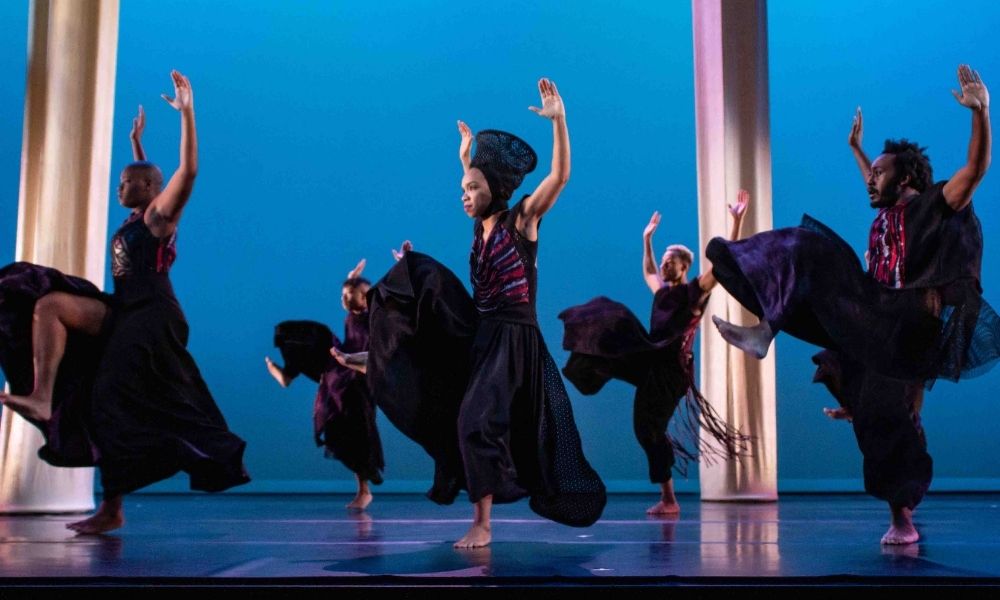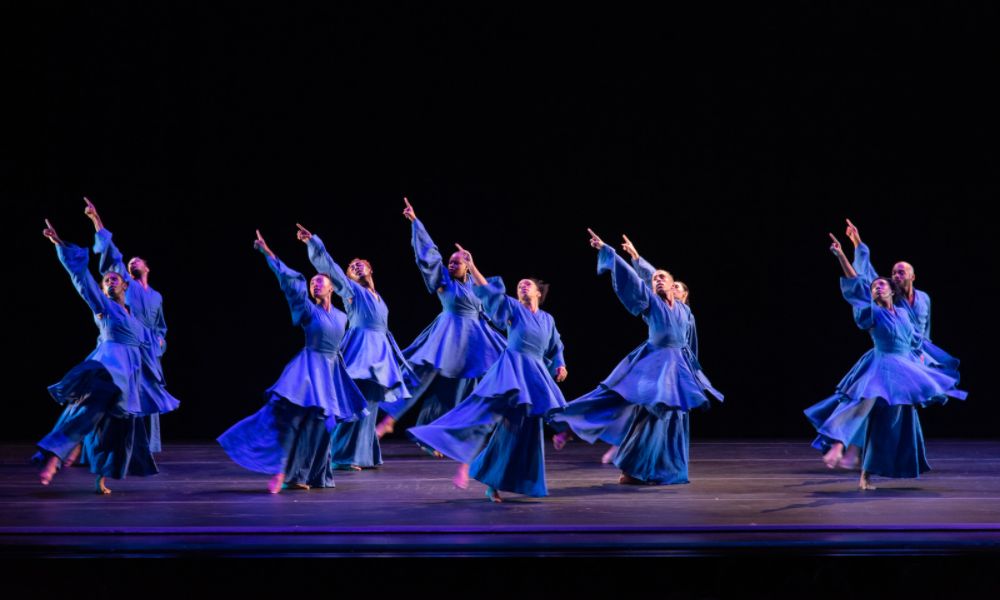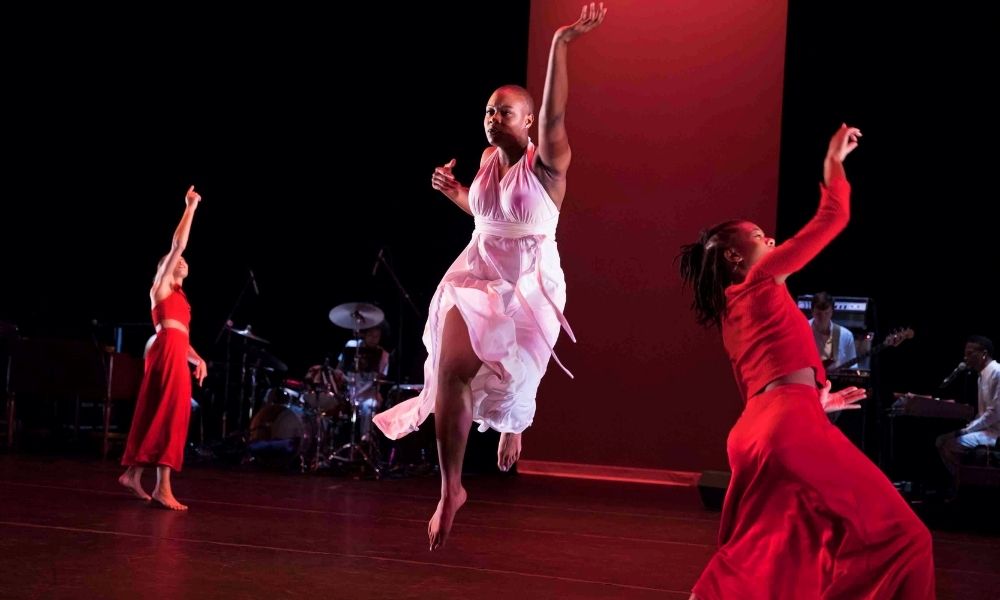Choreographer Ronald K. Brown is the dance world’s preeminent preacher. His works — exquisitely performed Thursday (through Saturday) evening at the Kennedy Center Eisenhower Theater — open the heart and lift the soul. EVIDENCE, the company he founded in 1985 in Brooklyn, gives voice to the cultural legacies and experiences of the African American community. The rich triptych of works, which spanned two decades, took the audience on a spiritual journey, accompanied by the historical underpinnings of the African American experience.

Like a semiotician, Brown imbues his choreography with gestures, structures, postures, signs, and signifiers that embody the Black experience. There’s the grounded way his dancers walk and stand, knees juicy as they give in and rebound to gravity’s pull, while their upper bodies pronounce themselves as unselfconsciously powerful and graceful. And then the torso, spine, and shoulders that undulate in a subtle acknowledgment, again, of the natural energies land, sea, and air written into our bodies.

Brown fashions his movement language with a complement of subtly semaphoric gestures that convey meaning — clenched fists, the dap or single raised fist, raised praising arms, arms up as if under arrest, and hand held at heart center. These and others become a revelatory vocabulary across the evening’s three works, without becoming mimetically obvious.
“Mercy” featured the accompaniment of Meshell Ndegeocello’s genre-slashing funk/soul/jazz/hip hop in a spare and contemplative score that shifts from meditative to a heavier rock beat allow the company of dancers to unfurl from simple walking to full-bodied tilts, bird-like arms in precarious balances, and whipping spins. The lighting by Tsubasa Kamei here is moody but a series of glowing fabric columns dispersed across the stage that hide and reveal the dancers lend a temple-like feel to the work.
Yet the dancers enter walking backward, as if the world has turned upside down. In fact, it has. As the piece progresses the six women and five men navigate the space in quick-footed shuffles and effortless ease. At one moment, the men tumble to the floor as the women continue dancing; at another, there’s a freeze-frame hands-up/don’t-shoot gesture. The reality of our nation’s divisions and sins is embedded in the dance. A priestess-like figure, clad in a regal woven headdress and the elegant deep brown gorgeously draped fabrics of costumer Omotayo Wunmi Olaiya, leaves the community for a solo that suggests compassion and healing drawing on Africanist movement vocabulary, rolling shoulders, undulating spines, winging arms and bent-knee steps. Deep-voiced Ndegeocello (who, by the way, studied at Oxon Hill High School and Duke Ellington as a teen) chants aphoristic phrases — “Have mercy on you,” “As you think, so shall you become,” “I’m at the mercy of the shifting sea” — as a prayer of healing.

Created this year, “The Equality of Night and Day: First Glimpse” features a score by Jason Moran and recorded clips of speeches from racial justice activist Angela Davis. While still a work-in-progress, the piece is well on its way to a full artistic statement. Dancers clad in rich blue choir-like robes suggest a movement choir in the way they circle, gather, and realign themselves to Moran’s jazzy, bluesy accompaniment. And this group-think construction becomes fitting, as we hear Davis questioning America’s democratic values and actions that she says “spawn terror.” “How,” she asks, “do we imagine democracy that doesn’t thrive on racism, homophobia, capitalism … [how do we] use our imagination to come up with new models of democracy.” The dancers appear in a Sisyphean struggle, then at moments they tremble, as if terrorized or exhausted. But the most powerful and lasting vision here is of simplicity: In a quiet moment as the dancers walk, circling up in a steady understated but regal gait. They shed their robes, neatly place them at the circle’s center, and become an offering.

Brown’s signature work, “Grace,” now two decades old, remains as fresh as it did in its earliest rendition in the Alvin Ailey American Dance Theater. Under golden sunny lights against a hot-red background, the white-clad dancers driving speed, shuffling quick-footed patters, space gulping leaps, and rolling spines from bent waists unfold over a pulsing beat, first churchy then jazzy and groovy. The incessant drive that binds these dancers as they expend every ounce of muscle, sinew, and bone to the utmost becomes the perfect way to elevate this program of faith-infused works. The trajectory Brown carves from the brooding over our nation’s state of societal dysfunction and prejudice and how to heal in “Mercy” to a call for action in “The Equality of Night and Day” reaches its apotheosis and, ultimately, a state of praise and blessing in “Grace.”
Running Time: 100 minutes, with two intermissions
Ronald K. Brown/EVIDENCE, featuring “Mercy,” “The Equality of Night and Day: First Glimpse,” and “Grace.,” performed October 21-23, 2021, at the Kennedy Center Eisenhower Theater, 2700 F Street NW, Washington, DC.




